This post may contain affiliate links. Please see our disclosure policy.
Canning Vegetable Broth gives you a rich base for your meals, right off your pantry shelf.
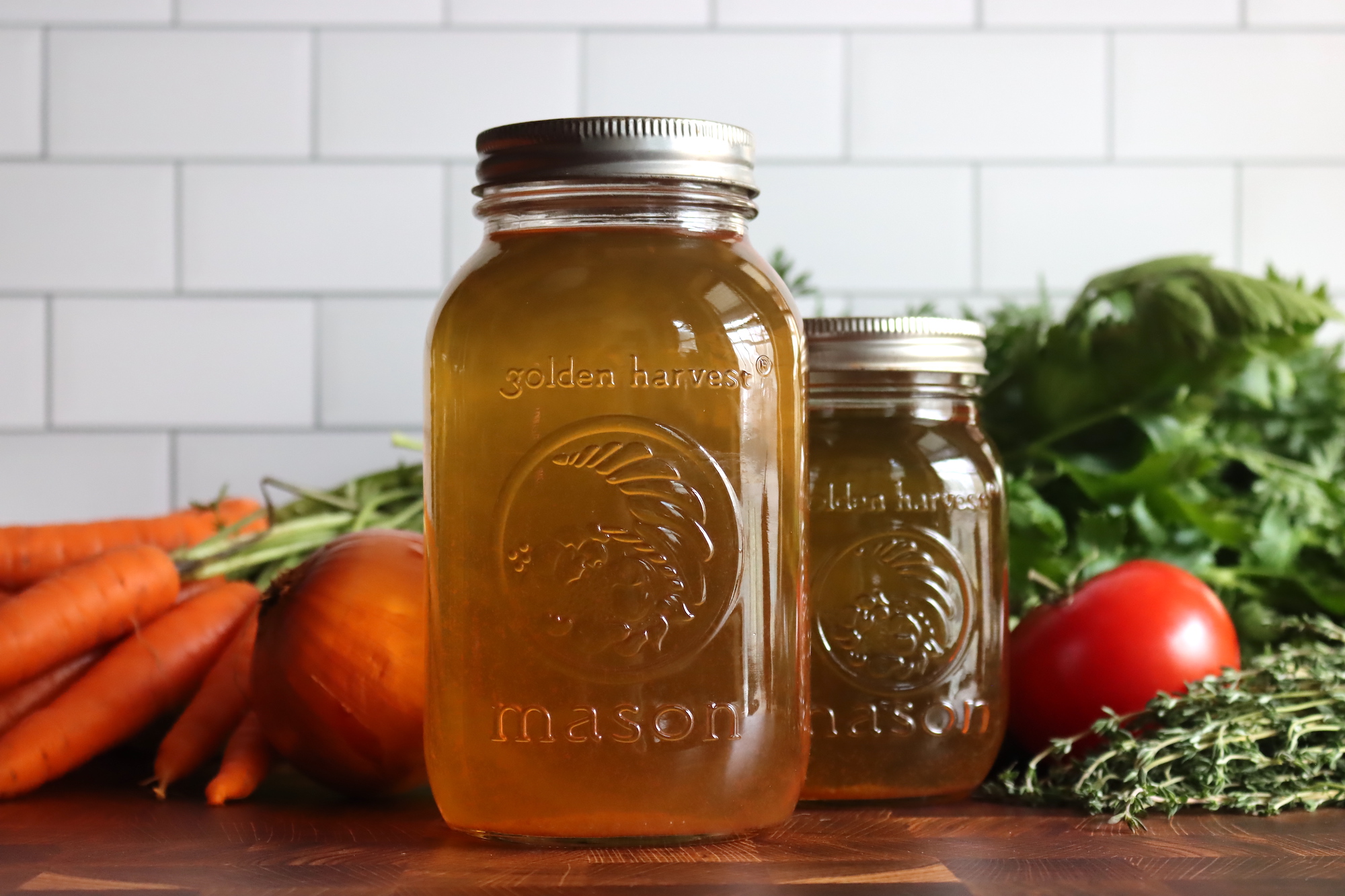
As the chilly months approach, there’s nothing like having a stash of delicious and nutritious vegetable broth on hand in your pantry. Not only can it be used to add a flavorful boost to your favorite soups and stews, but it can also serve as a comforting warm beverage on its own.
While store-bought options are available, homemade vegetable broth is a healthier and more sustainable alternative.
Below, we’ll guide you through the process of canning your homemade vegetable broth, revealing the ingredients needed, the method to follow, and tips on serving this nourishing concoction.
Ingredients for Vegetable Broth
You can, in fact, can any recipe for vegetable broth that you can think up. Really, all that’s required is that you simmer vegetables until their rich flavors infuse into the broth, and then completely strain before canning. The only real exception to this is that you shouldn’t use starchy vegetables (like potatoes) as they can add lots of soluble starch to the mix…which not only clouds your broth, but also could affect canning times.
Few people put starchy vegetables in broth anyway, so it’s not really an issue, but it’s still worth mentioning.
This particular recipe for vegetable broth is one that I’ve tested, and it’s adapted from the The Ball Blue Book Guide to Preserving. A very similar recipe can also be found in Angi Schneider’s Pressure Canning for Beginners and Beyond.
The ingredients for canning vegetable broth are quite simple. To make a canner batch of 14 pints or 7 quarts, you’ll need the following:
- 3 cups (384 grams) sliced carrots
- 2 lbs (907 grams) quartered onions
- 3 cups (303 grams) celery
- 2 chopped rell bed peppers
- 2 large tomatoes, chopped and seeded
- 3 bay leaves
- 3 cloves garlic, crushed
- 1 tsp dried thyme (you can substitute 2-3 fresh sprigs)
- 1 tsp dried rosemary (you can substitute 1-2 fresh sprigs)
- 1 tsp dried parsley (or a small fresh bunch)
- 10 whole peppercorns
- 2 gallons (7.6) L water
You will need roughly 1 ¼ lbs (567 grams) of unprepared carrots and six to seven celery ribs. You’ll also need three to four whole onions for this recipe.
If you would like to make beef or chicken broth instead of vegetable broth, you can still use this recipe but with one simple adaptation. Use only half the vegetables and add raw chicken or beef bones with any scraps of meat you have to your stockpot. The ideal ratio is three to four pounds of bones with a few bits of meat.
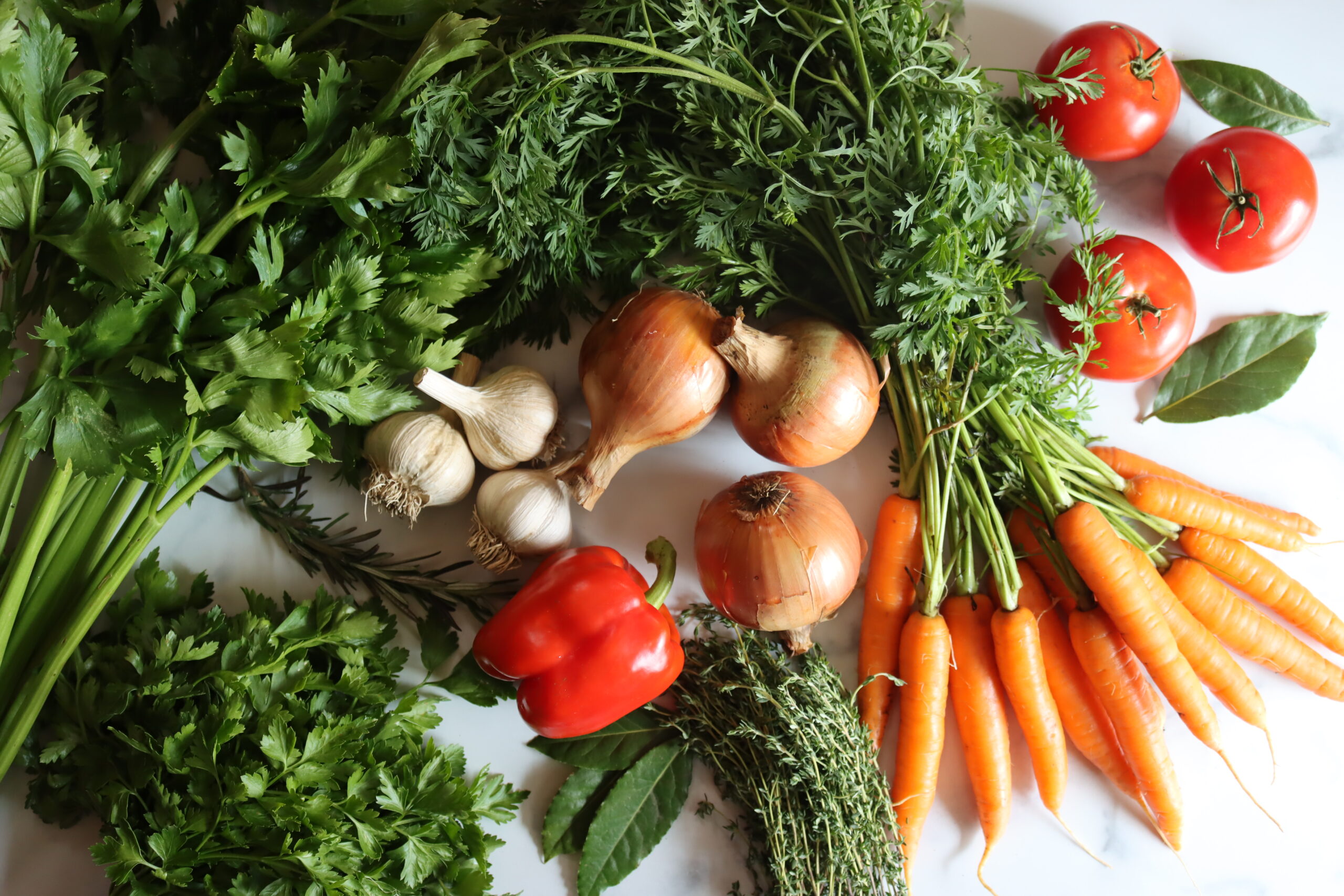
Canning Vegetable Broth
Start by washing and rinsing all of your vegetables and herbs. Make sure they’re free of any debris. You don’t need to peel the vegetables, since they will be strained out of the broth before serving, but you will need to chop them.
After chopping and washing the vegetables, combine all of your ingredients in a large stockpot. Bring the mixture to a boil over medium-high heat, then reduce the heat and simmer for two hours.
Prepare your pressure canner by washing it and its rack. Then, place the bottom rack inside the canner and fill it with a few inches (8 cm) of water. This will be based on your manufacturer’s recommendations – some manufacturers require more water, some require less.
Put the pressure canner on the stove over low heat while you prepare the broth and jars. Because this is a hot pack recipe, you will want to make sure the water in the canner is about 180 degrees Fahrenheit (or 82 degrees Clesius) before you load your jars and start canning.
Wash the jars in hot, soapy water and examine each one for any nicks or cracks. Place the jars in the canner so they stay hot. Do the same for the lids, washing them in hot, soapy water, then setting them aside.
Returning to your broth, carefully strain the solids from the liquid. To do this, place a colander lined with cheesecloth over a second stockpot. Ladle the broth into the colander. Allow four minutes for it to completely drain – don’t mash it, or this will cause the broth to become cloudy. Discard the solids.
Reheat the broth until it’s boiling, then remove the stockpot from the heat. Ladle the broth into prepared jars, leaving an inch (2.5 cm) of headspace.
Wipe the rims of the jars with a clean, damp cloth. Then, place the lids and bands on the jars and tighten them until they are fingertip-tight before you load them into the pressure canner.
Process the jars according to the manufacturer’s instructions at 10 lbs pressure for 30 minutes for pints and 35 minutes for quarts. Adjust for altitude if necessary.
When the processing time has finished, let the canner depressurize naturally. Remove the jars and allow them to cool on the counter for 12 hours. Check the seals, label, and store for one year.
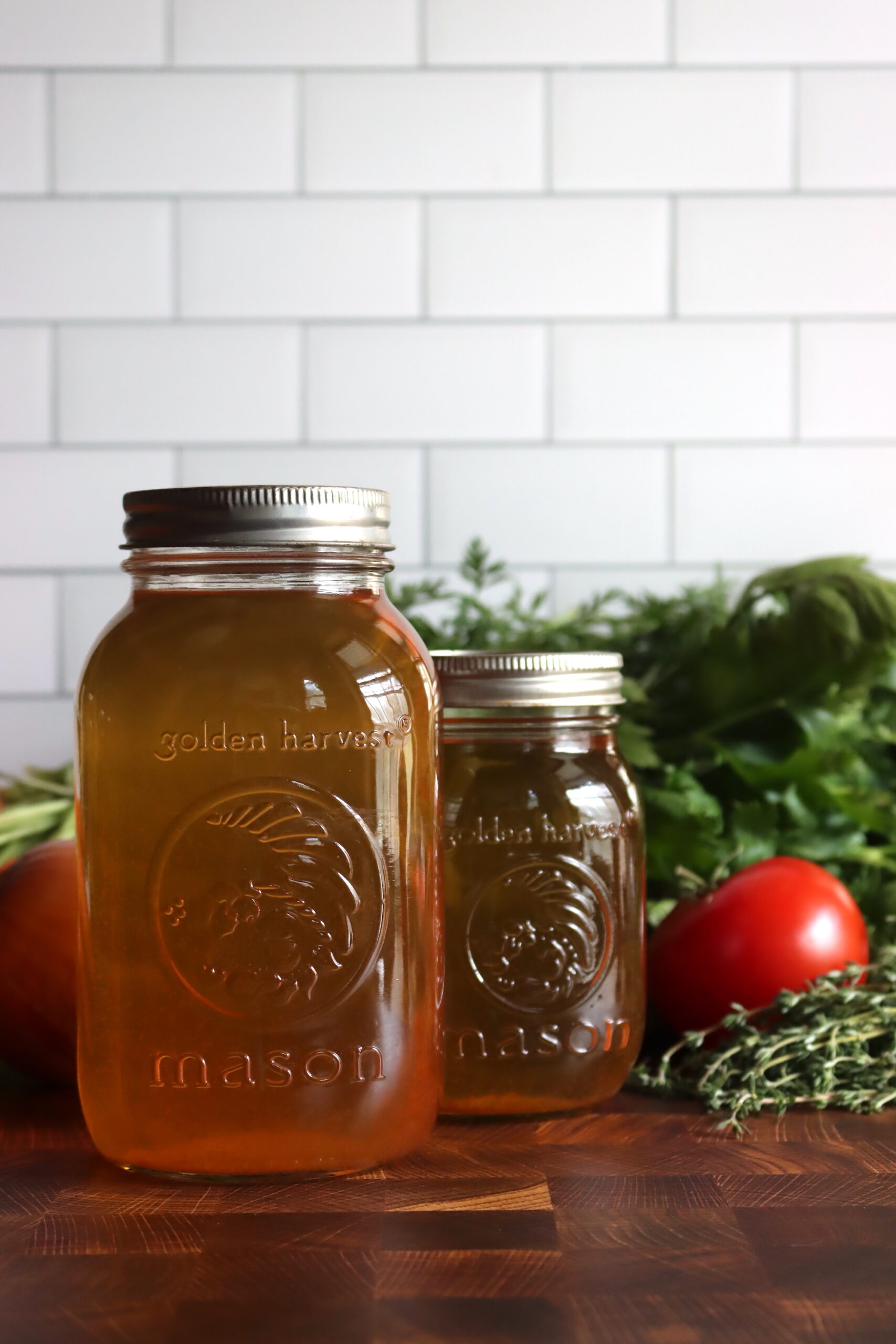
Altitude Adjustments for Canning Vegetable Broth
Canning time remains the same regardless of altitude. However, the processing pressure increases as altitude increase.
Use the following table to determine the correct processing pressure if you’re above 1,000 feet in elevation.
For dial gauge pressure canners:
- 0 to 2,000 feet in elevation – 11 lbs pressure
- 2,001 to 4,000 feet in elevation – 12 lbs pressure
- 4,001 to 6,000 feet in elevation – 13 lbs pressure
- 6,001 to 8,000 feet in elevation – 14 lbs pressure
For weighted gauge pressure canners:
- 0 to 1,000 feet in elevation – 10 lbs pressure
- Above 1,000 feet – 15 lbs pressure
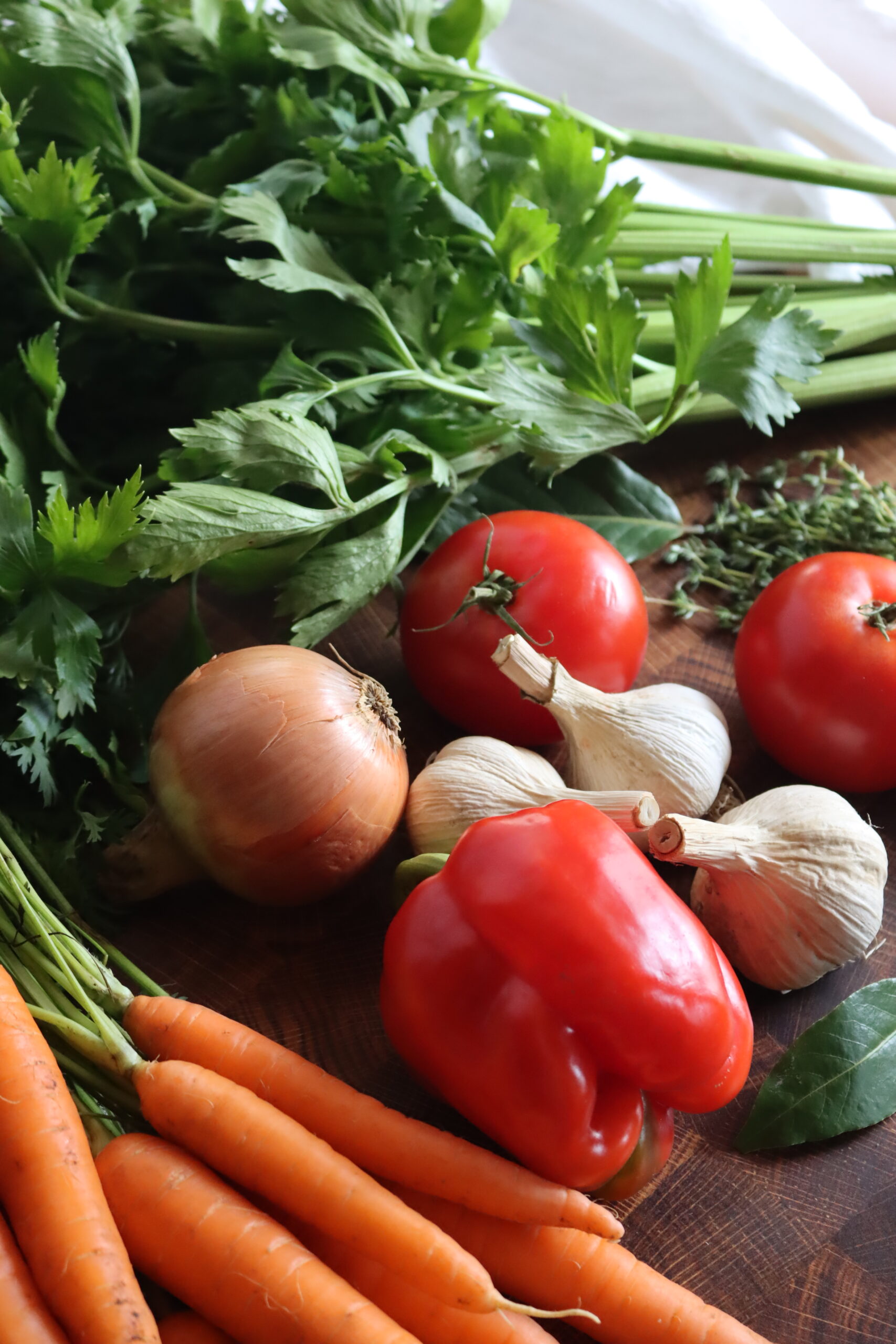
Serving Vegetable Broth
Canned vegetable broth can serve a variety of culinary purposes. Heat and enjoy it as a warming beverage on its own or use it to elevate your favorite soup, stew, and sauce recipes. You can even use it to cook rice and pasta, adding an additional boost of flavor and nutrients.
When using canned vegetable broth, do a taste test before adding any additional salt or seasoning, as it may already be sufficiently flavored from the canning process.
Canning vegetable broth is a simple, economical, and environmentally friendly way to ensure a steady supply of nourishing and delicious homemade broth at your fingertips. With this guide, you can confidently produce your very own canned vegetable broth to enjoy throughout the year.

Canning Vegetable Broth
Equipment
Ingredients
- 3 cups 384 grams sliced carrots
- 2 lbs 907 grams quartered onions
- 3 cups 303 grams celery
- 2 medium Rell bed peppers, chopped
- 2 large tomatoes, chopped and seeded
- 3 medium bay leaves
- 3 cloves garlic, crushed
- 1 tsp dried thyme, you can substitute 2-3 fresh sprigs
- 1 tsp dried rosemary, you can substitute 1-2 fresh sprigs
- 1 tsp dried parsley, or a small fresh bunch
- 10 whole peppercorns
- 2 gallons water
Instructions
- Start by washing and rinsing all of your vegetables and herbs.
- Combine all of your ingredients in a large stockpot.
- Bring the mixture to a boil over medium-high heat, then reduce the heat and simmer for two hours.
- Prepare your pressure canner by washing it and its rack. Then, place the bottom rack inside the canner and fill it with a few inches (8 cm) of water.
- Put the pressure canner on the stove over low heat while you prepare the broth and jars. Make sure the water in the canner is about 180 degrees Fahrenheit (or 82 degrees Celsius) before you load your jars and start canning.
- Wash the jars in hot, soapy water and examine each one for any nicks or cracks. Place the jars in the canner so they stay hot. Do the same for the lids, washing them in hot, soapy water, then setting them aside.
- Returning to your broth, carefully strain the solids from the liquid. To do this, place a colander lined with cheesecloth over a second stockpot. Ladle the broth into the colander. Allow four minutes for it to completely drain – don't mash it, or this will cause the broth to become cloudy. Discard the solids.
- Reheat the broth until it's boiling, then remove the stockpot from the heat.
- Ladle the broth into prepared jars, leaving an inch (2.5 cm) of headspace.
- Wipe the rims of the jars with a clean, damp cloth. Then, place the lids and bands on the jars and tighten them until they are fingertip-tight before you load them into the pressure canner.
- Process the jars according to the manufacturer's instructions at 10 lbs pressure for 30 minutes for pints and 35 minutes for quarts. Adjust for altitude if necessary, see notes.
- Let the canner depressurize naturally. Remove the jars and allow them to cool on the counter for 12 hours. Check the seals, label, and store for one year.
Notes
Recipe Changes
You can, in fact, can any recipe for vegetable broth that you can think up. Really, all that's required is that you simmer vegetables until their rich flavors infuse into the broth, and then completely strain before canning. The only real exception to this is that you shouldn't use starchy vegetables (like potatoes) as they can add lots of soluble starch to the mix…which not only clouds your broth, but also could affect canning times. Few people put starchy vegetables in broth anyway, so it's not really an issue, but it's still worth mentioning. This particular recipe for vegetable broth is one that I've tested, and it's adapted from the The Ball Blue Book Guide to Preserving. A very similar recipe can also be found in Angi Schneider's Pressure Canning for Beginners and Beyond.Altitude Adjustments for Canning Vegetable Broth
Canning time remains the same regardless of altitude. However, the processing pressure increases as altitude increase. Use the following table to determine the correct processing pressure if you’re above 1,000 feet in elevation.For dial gauge pressure canners:
- 0 to 2,000 feet in elevation – 11 lbs pressure
- 2,001 to 4,000 feet in elevation – 12 lbs pressure
- 4,001 to 6,000 feet in elevation – 13 lbs pressure
- 6,001 to 8,000 feet in elevation – 14 lbs pressure
For weighted gauge pressure canners:
- 0 to 1,000 feet in elevation – 10 lbs pressure
- Above 1,000 feet – 15 lbs pressure
Nutrition
Nutrition information is automatically calculated, so should only be used as an approximation.
Vegetarian Canning Recipes
Need a few more ways to put veggies in a jar?
- Canning Carrot Soup
- Canning Butternut Squash Soup Base
- Canning Butternut and White Bean Soup
- Canning Thai Coconut Squash Soup
Stock and Broth Canning Recipes
Homemade broth and stock recipes are easy to preserve in a pressure canner!
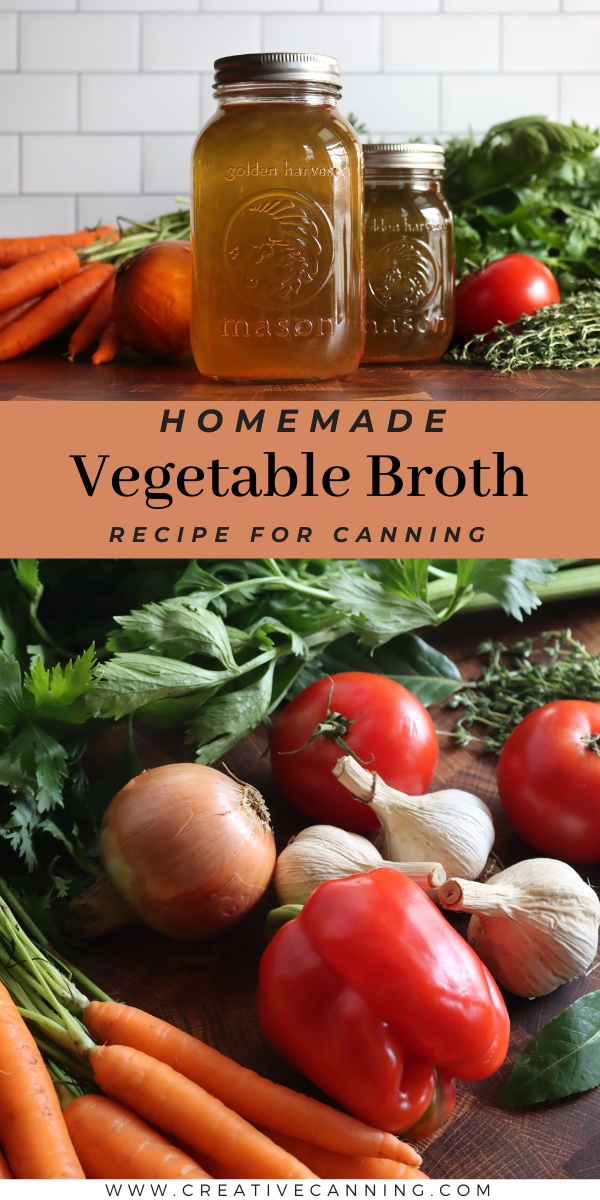
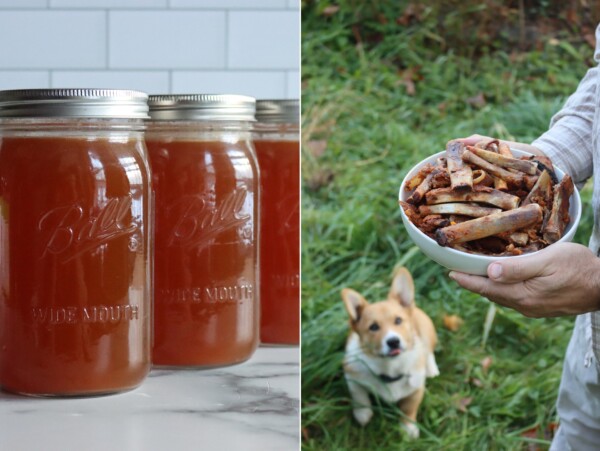
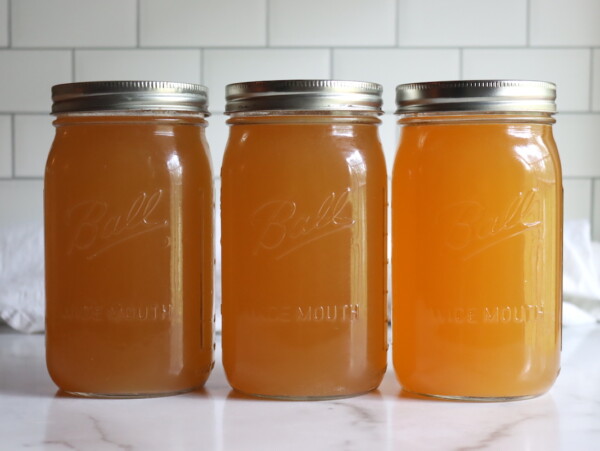
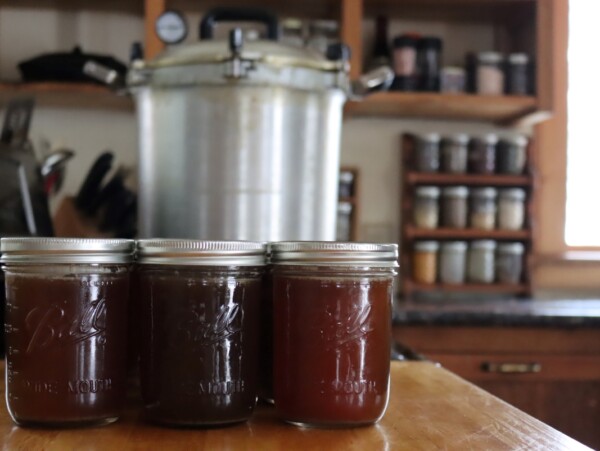
I think I will purée all those veggies in my Vitamix and add them to my veg broth. It’s a waste of good nutrients. Thanks for a great recipe. Jan
If you puree the veggies, be aware that the result won’t be safe for canning with these short times. The mixture has to be thin as water, with no solids in it (even pureed) to be canned for the times used for veggie broth.
Hi, can you comment on the time? I’ve heard that the Ball Blue Book says 35 minutes for vegetable stock (but 25 min for chicken and beef stocks) which doesn’t make sense to me but I can’t find an authoritative source other than this (and now you).
Well that is interesting…I pulled my canning times from the All American Pressure Canner Manual, which has “soup stock” listed just once and says 20 and 25 minutes. It is interesting that Ball Canning is opting for a longer time for vegetable stock, which doesn’t make sense when you think about it. There’s no specific recipe for stock in any case, you just toss in your ingredients, strain well and can. You can, in fact, make beef stock using the exact same ingredients you use for veggie stock…plus a beef bone or two.
If I had to guess at a reason, I’d say it’s because sometimes when people are making vegetable stock, they add things that you really wouldn’t ever put in a meat stock. For example, I’ve seen people that put potato peelings in vegetable stock (though it’s a horrible idea, they don’t taste great, but they’re trying to use up every scrap somehow). When you put in those types of starchy veggies it can make the stock a bit thicker and starchier, so I imagine Ball Canning is just tossing on extra time there out of an abundance of caution.
In general, I try to follow the most conservative advice on canning times, so given that, I’ll go in and change the canning times in this recipe to be in line with what the Ball Blue Book has published.